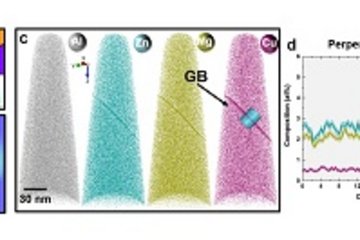All genres
81.
Talk
Enhancing mechanical properties of calcite by Mg substitutions - An ab initio study. American Physical Society - March Meeting, Dallas, TX, USA (2011)
82.
Talk
Ab initio study of thermodynamic, structural, and elastic properties of Mg-substituted crystalline calcite. TMS 2011, San Diego, CA, USA (2011)
83.
Talk
Arthropod cuticle: A biological multi-functional composite used as template for nano-to-macro-scale hierarchical modelling. Euro BioMat, Jena, Germany (2011)
84.
Talk
Arthropod cuticle: A biological multi-functional composite used as template for nano-to-macro-scale hierarchical modelling. THERMEC 2011, Quebec, Canada (2011)
85.
Talk
Enhancing mechanical properties of calcite by Mg substitutions: A quantum-mechanical study. Multiscale design modeling 2010, Brno, Czech Republic (2010)
86.
Talk
Atomistic study of the Hydrogen enhanced local plasticity (HELP) mechanism. ADIS 2010, Mechanical Properties, Ringberg, Germany (2010)
87.
Talk
Arthropod cuticle: A biological multi-functional composite used as template for nano-to-macro-scale hierarchical modeling. Multiscale Materials Modeling, Freiburg, Germany (2010)
88.
Talk
GaN(0001) Surface States: A Comparison Between Photoelectron Spectroscopy and Density Functional Theory. International Workshop on Nitride Semiconductors, Tampa, Florida, USA (2010)
89.
Talk
Ab initio Based Growth Simulations of III-Nitride Nanowires. International Workshop on Nitride Semiconductors, Tampa, Florida, USA (2010)
90.
Talk
Ab initio based study of multi-scale elastic properties of hierarchical biocomposites. Seminar talk at Masaryk University, Brno, Czech Republic (2010)
91.
Talk
Ab initio Based Growth Simulations of III-Nitride nanowires. DPG Frühjahrstagung 2010, Regensburg, Germany (2010)
92.
Talk
Arthropod Cuticle: A Biological Multifunctional Composite Used As Template for Multidisciplinary Nano-To-Macro-Scale Hierarchical Modeling. 139th Annual Meeting of the Minerals, Metals and Materials Society (TMS), Seattle, WA, USA (2010)
93.
Talk
Embrittlement in metals: An atomistic study of the Hydrogen enhanced local plasticity (HELP) mechanism. 139th Annual Meeting of the Minerals, Metals and Materials Society (TMS), Seattle, WA, USA (2010)
94.
Talk
Ab-initio based growth simulations of III-Nitride nanowires. Computational Materials Science on Complex Energy Landscapes Workshop, Imst, Austria (2010)
95.
Talk
Extremal stiffness of crustacean cuticle through hierarchical optimization: Theory, modeling, and experiment. 3rd International Conference on Mechanics of Biomaterials & Tissues, multiscale modeling of tissue mechanical properties, Clearwater Beach, FL, USA (2009)
96.
Talk
Understanding embrittlement in metals: A multiscale study of the Hydrogen-enhanced local plasticity mechanism. Materials Research Society (MRS) Fall meeting, Boston, MA, USA (2009)
97.
Talk
Adatom Kinetics, Thermodynamics, and Si Incorporation on Non-Polar III-Nitride Surfaces: Implications on Nanowire Growth. 8th nternational Conference on Nitride Semiconductors, Jeju Island, South Korea (2009)
98.
Talk
Hierarchical modeling of the elastic properties of lobster cuticle via first principles calculations and mean-field homogenization. 1st International Conference on Material Modeling, Dortmund, Germany (2009)
99.
Talk
Multi-Scale Hierarchical Modeling of the Mechanical Properties of Lobster Cuticle. EUROMAT 2009, Glasgow, UK (2009)
100.
Talk
A multiscale study of the Hydrogen-enhanced local plasticity (HELP) mechanism. Euromat 2009, Glasgow, U.K. (2009)











